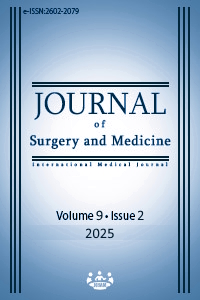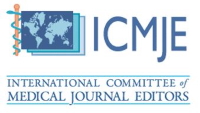Endoscopic versus microscopic tympanoplasty: A prospective randomized comparison of outcomes
Endoscopic versus microscopic tympanoplasty
Keywords:
Tympanoplasty, Endoscopic, Microscopic, Functional outcome, Type-1Abstract
Background/Aim: There is a limited number of systematic comparisons and comprehensive studies on auditory outcomes, graft success, and complication rates between traditional microscopic and newer endoscopic tympanoplasty techniques. Hence, we aim to compare these two techniques, namely endoscopic and microscopic type-1 tympanoplasty, in terms of anatomical and functional outcomes.
Methods: This prospective randomized clinical trial included 40 adult patients, divided equally between those undergoing microscopic and endoscopic tympanoplasty. To eliminate selection bias, the sequence of operations alternated between the two methods based on the patients’ arrival order. Each patient’s pre-operative conditions and outcomes 6 months post-surgery were evaluated using pure tone audiometry tests and assessments of the tympanic membrane. For both groups, the tragal perichondrial cartilage composite graft served as graft material. Functional assessments evaluated the air conduction threshold and bone conduction threshold averages at frequencies of 500, 1000, 2000, and 4000 Hz, both pre-operatively and 3 months after the operation. Air conduction gain was determined by comparing the air bone gap at application with that 6 months post-surgery. The size of the tympanic membrane perforation was calculated as a percentage of the total area using ImageJ, and the correlation with functional gain was assessed. The condition of the tympanic membrane and graft position were documented 6 months post-surgery using IBM SPSS Statistics Version 26.
Results: We compared mean (standard deviation [SD]) pre-operative air conduction threshold values between the endoscopic group (30.11 [5.19]) and the microscopic group (28.45 [5.19]) and found no significant difference (P=0.404). Similarly, we found no significant difference (P=0.169) in pre-operative air bone gap values between the endoscopic group (24.58 [5.35]) and the microscopic group (27.17 [6.34]). Post-operative air conduction threshold values in the endoscopic group (17.09 [11.28]) and the microscopic group (13.55 [7.99]) also showed no significant difference (P=0.258). The same was true for post-operative air bone gap values in the endoscopic group (13.97 [10.91]) and the microscopic group (9.63 [7.83]) (P=0.156). The average air conduction gain, an indicator we used to evaluate the functional success of the surgery, was similarly non-significant between the endoscopic group (13.08 [7.47]) and the microscopic group (14.90 [5.04]) (P=0.395).
Conclusion: Our study findings suggest that an endoscope is at least as effective as the microscopic method in type-1 tympanoplasty. Moreover, with advantages like reduced surgical time and broad-angle viewing capabilities, the endoscopic method is poised to gain popularity.
Downloads
References
Dündar R, Kulduk E, Soy FK, Aslan M, Hanci D, Muluk NB, et al. Endoscopic versus microscopic approach to type 1 tympanoplasty in children. Int J Pediatr Otorhinolaryngol. 2014 Jul;78(7):1084-9. doi: 10.1016/j.ijporl.2014.04.013. DOI: https://doi.org/10.1016/j.ijporl.2014.04.013
Wullstein HL. Funktionelle operation in mittelohr mit hilfe des freien spaltlappen-transplantates. Arch Ohren Nasen Kehlkopfheilkd. 1952;161:422-35. DOI: https://doi.org/10.1007/BF02129204
Zöllner F. The principles of plastic surgery of the sound-conducting apparatus. J Laryngol Otol. 1955 Oct;69(10):637-52. DOI: https://doi.org/10.1017/S0022215100051240
Wullstein H. Theory and practice of tympanoplasty. Laryngoscope. 1956 Aug;66(8):1076-93. doi: 10.1288/00005537-195608000-00008. DOI: https://doi.org/10.1288/00005537-195608000-00008
Mudry A. History of myringoplasty and tympanoplasty type I. Otolaryngol Head Neck Surg. 2008;139:613–4. DOI: https://doi.org/10.1016/j.otohns.2008.07.0l4
Mutlu F, Durmuş K, Öztürk M, Değer HM. Comparison of anterior tab flap and underlay tympanoplasty techniques in anterior tympanic membrane perforations. J Surg Med. 2021 Sep. 1 [cited 2024 May 7];5(9):917-20. DOI: https://doi.org/10.28982/josam.982871
Kirazli T, Bilgen C, Midilli R, Ogüt F. Hearing results after primary cartilage tympanoplasty with island technique. Otolaryngol Head Neck Surg. 2005 Jun;132(6):933-7. doi: 10.1016/j.otohns.2005.01.044. DOI: https://doi.org/10.1016/j.otohns.2005.01.044
Yang T, Wu Q, Peng Q, Zhang Y, Qie S, Sun H. Comparison of cartilage graft and fascia in type 1 tympanoplasty: systematic review and meta-analysis. Acta Otolaryngol. 2016;136(11):1085-90. DOI: https://doi.org/10.1080/00016489.2016.1195013
Nassif N, Berlucchi M, de Zinis LOR. Tympanic membrane perforation in children: endoscopic type I tympanoplasty, a newly technique, is it worthwhile? Int J Pediatr Otorhinolaryngol. 2015;79(11):1860-4. DOI: https://doi.org/10.1016/j.ijporl.2015.08.025
Tan HE, Santa Maria PL, Eikelboom RH, Anandacoomaraswamy KS, Atlas MD. Type i tympanoplasty meta-analysis: a single variable analysis. Otol Neurotol. 2016;37(7):838-46. DOI: https://doi.org/10.1097/MAO.0000000000001099
Coskun BU, Cinar U, Seven H, Ugur S. The effects of the incision types in myringoplasty operations on cosmetics. Eur Arch Otorhinolaryngol. 2006;263:820-2. DOI: https://doi.org/10.1007/s00405-006-0069-z
Kessler A, Potsic WP, Marsh RR. Type I tympanoplasty in children. Arch Otolaryngolog Head Neck Surg. 1994;120:487-90. DOI: https://doi.org/10.1001/archotol.1994.01880290005001
Jako GJ. Postaural versus endaural exposure in tympanoplasty. Laryngoscope. 1967;77:2022-31. DOI: https://doi.org/10.1288/00005537-196711000-00007
Halim A, Borgstein J. Pediatric myringoplasty: postaural versus transmeatal approach. Int J Pediatric Otorhinolaryngol. 2009;73:1580-3. DOI: https://doi.org/10.1016/j.ijporl.2009.08.010
Tarabichi M. Endoscopic management of acquired cholesteatoma. Am J Otol. 1997;18:544-9.
Kakehata S, Watanabe T, Ito T, Kubota T, Furukawa T. Extension of indications for transcanal endoscopic ear surgery using an ultrasonic bone curette for cholesteatomas. Otol Neurotol. 2014;35:101-7. DOI: https://doi.org/10.1097/MAO.0b013e3182a446bc
Patil RN. Endoscopic tympanoplasty-Definitely advantageous. Asian J Ear Nose Throat. 2003;25:9-13.
Gkrinia E, Ntziovara AM, Brotis AG, Tzimkas-Dakis K, Saratziotis A, Korais C, et al. Endoscopic Versus Microscopic Tympanoplasty: A Systematic Review and Metanalysis. Laryngoscope. 2024 Feb 28. doi: 10.1002/lary.31365. Epub ahead of print. DOI: https://doi.org/10.1002/lary.31365
Raj A, Mejer R. Endoscopic Transcanal myringoplasty—a study. Indian J Otolaryngol Head Neck Surgery. 2001;53(1):47-9. DOI: https://doi.org/10.1007/BF02910979
Harugop AS, Mudhol RS, Godhi RA. A comparative study of endoscope assisted myringoplasty and microscope assisted myringoplasty. Indian J Otolaryngol Head Neck Surg. 2008;60(4):298-302. DOI: https://doi.org/10.1007/s12070-008-0099-5
Lade H, Choudhary SR, Vashishth A. Endoscopic vs microscopic myringoplasty: a different perspective. Eur Arch Otorhinolaryngol. 2014;271(7):1897-902. DOI: https://doi.org/10.1007/s00405-013-2673-z
Kaftan H, Noack M, Friedrich N, Völzke H, Hosemann W. Prävalenz chronischer Trommelfellperforationen in der Erwachsenen Bevölkerung. HNO. 2008;56(2):145-50. DOI: https://doi.org/10.1007/s00106-007-1574-0
Ayache S. Cartilaginous myringoplasty: The endoscopic transcanal procedure. Eur Arch Otorhinolaryngol. 2013;270(3):853-60. DOI: https://doi.org/10.1007/s00405-012-2056-x
Pap I, Tóth I, Gede N, Hegyi P, Szakács Z, Koukkoullis A, et al. Endoscopic type I tympanoplasty is as effective as microscopic type I tympanoplasty but less invasive-A meta-analysis. Clin Otolaryngol. 2019 Nov;44(6):942-53. doi: 10.1111/coa.13407. DOI: https://doi.org/10.1111/coa.13407
Gülsen S, Arici M. Endoscopic transcanal versus conventional microscopic tympanoplasty in treatment of anterior tympanic membrane perforations. Eur Arch Otorhinolaryngol. 2019;276(12):3327-33. DOI: https://doi.org/10.1007/s00405-019-05646-8
Gülsen S, Baltaci A. Comparison of endoscopic transcanal and microscopic approach in type 1 tympanoplasty. Braz J Otorhinolaryngol. 2021;87(2):157-63. DOI: https://doi.org/10.1016/j.bjorl.2019.07.005
Bennett ML, Zhang D, Labadie RF, Noble JH. Comparison of middle ear visualization with endoscopy and microscopy. Otol Neurotol. 2016;37(4):362-6. DOI: https://doi.org/10.1097/MAO.0000000000000988
Manna S, Kaul VF, Gray ML, Wanna GB. Endoscopic versus microscopic middle ear surgery: a meta-analysis of outcomes following tympanoplasty and stapes surgery. Otol Neurotol. 2019;40(8):983-93. DOI: https://doi.org/10.1097/MAO.0000000000002353
Tseng CC, Lai MT, Wu CC, Yuan SP, Ding YF. Comparison of the efficacy of endoscopic tympanoplasty and microscopic tympanoplasty: a systematic review and meta-analysis. Laryngoscope. 2017;127(8):1890-6. DOI: https://doi.org/10.1002/lary.26379
Shakya D, Arun KC, Nepal A. A comparative study of endoscopic versus microscopic cartilage type I tympanoplasty. Int Arch Otorhinolaryngol. 2020;24(1):E80-5. DOI: https://doi.org/10.1055/s-0039-1693139
Anschuetz L, Bonali M, Guarino P, Fabbri FB, Alicandri-Ciufelli M, Villari D, et al. Management of Bleeding in Exclusive Endoscopic Ear Surgery: Pilot Clinical Experience. Otolaryngol Head Neck Surg. 2017 Oct;157(4):700-6. doi: 10.1177/0194599817726982. DOI: https://doi.org/10.1177/0194599817726982
Downloads
- 595 1024
Published
Issue
Section
How to Cite
License
Copyright (c) 2025 Burak Ulkumen, Ali Vefa Yuceturk
This work is licensed under a Creative Commons Attribution-NonCommercial-NoDerivatives 4.0 International License.
















